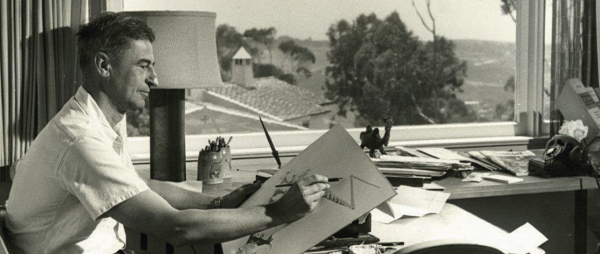THEODOR GEISEL, WRITER AND ILLUSTRATOR
“I like nonsense; it wakes up the brain cells.”

In the early 1920s, Theodor Geisel, a promising young writer with ambitions as a humorist and illustrator was caught drinking at Dartmouth College. With strict prohibition laws in place, his punishment was to be discharged from the college’s satirical magazine, the Jack-O-Lantern. To continue contributing, he wrote anonymously under the name “Seuss.”
In 1927, he moved to New York and began writing and drawing for magazines and advertizers. The same year he added “Dr” to his pen name. Through the 1930s this work bought success, boosted by his books published throughout the 1930s. During World War II, he turned his thriving wit to political cartoons, using humor to denounce Hitler and Mussolini, and later to support US involvement.
Seuss, his mother’s maiden name, was pronounced “Zoice” by the family. Geisel switched to the anglicized pronunciation because “most people naturally said it that way.” He added Dr to his name because his father had always wanted him to practice medicine.
During his career, he published over 60 children’s books, some under another pen name Theo LeSieg. He also wrote for many film and television projects. In 2000, when Publishers Weekly compiled their list of the best-selling children’s books of all time, 16 of the top 100 books were written by Geisel.
He wrote most of his books in the bold “anapestic tetrameter,” a meter favored by many poets. This technique has four anapestic metrical feet per line and each foot has two unstressed syllables followed by a stressed syllable. It is sometimes referred to as a “reverse dactyl” and permits a driving pace through the words. It is a style well suited for comic verse and was often adopted by Geisel. Commentators offer this as one of the key reasons Geisel’s writing has been so well received.
“The main problem with writing in verse is, if your fourth line doesn’t come out right, you’ve got to throw four lines away and figure out a whole new way to attack the problem. So, the mortality rate is terrific.”
His drawing style was equally bold. Vivid motion, eccentric characters, complex and impossible machines, elaborate architecture. Geisel also follows the classic cartoon tradition of using motion lines—the abstract marks behind a moving object or person—to make it appear as if it is moving quickly.
Largely disguised in the humor, Geisel incorporated lessons of morality and human nature. He made a point of not beginning to write his stories with a moral in mind—”Kids can see a moral coming a mile off!”—but they were to educate as well as entertain.
In a time when children’s printed literature must compete with an array of digital rivals, through his idiosyncratic humor, wild words, and eccentric images, Dr Seuss endures.
“From there to here, and here to there, funny things are everywhere.
HAPPENING
August 10, 11, 12, 10am–2pm

STONE CARVING
with Jesse Ensling
Unlock your creativity in this engaging sculpture workshop.
Member: $218, Non-member: $242
Tuesday, August 15, 10–11am

COFFEE & MOTHER EARTH: GARDENING AS WE AGE
with Priscilla Husband
Tips and secrets to continue creating beautiful gardens!
Member: $14, Non-member: $16

